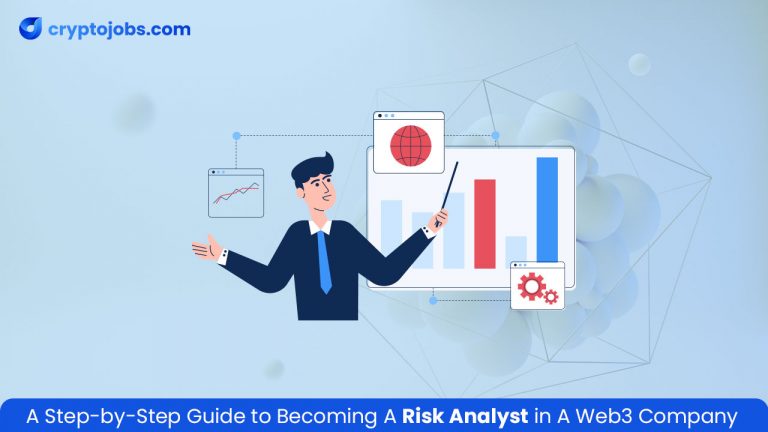
A Step-by-Step Guide to Becoming a Risk Analyst in A Web3 Company
- cryptojobs.com
- February 23, 2024
- All Posts, Career Guide
- Web3
- 0 Comments
Immersed in the dynamic realm of the Web3 industry, the role of a risk analyst or risk assessor takes on a transformative edge. Specializing in foreseeing the potential consequences of specific actions within this decentralized landscape, these experts leverage available data for the benefit of the company or client.
Drawing insights from correlations and patterns in past events and emerging data, they help organizations as they explore new ventures, customers, policies, or political endeavors. A Web3 risk analyst diligently identifies potential liabilities and assesses the likelihood of achieving positive outcomes for the best outcomes for the company or clients.
If this sounds like the job for you, continue reading as we dive deep into how you can start your career as a Web3 risk analyst.
Step 1: Explore Your Educational Pathway
After assessing risk analyst resumes, it was revealed that 87% of all candidates possess a bachelor’s degree, while 16.4% have pursued master’s degrees. Surprisingly, some risk analysts have entered the field with only a high school diploma or GED.
Since a staggeringly large number of risk analysts boast at least a bachelor’s degree, it is imperative to enhance your competitiveness in the job market with a relevant bachelor’s program. Fields such as business, information technology, finance, or accounting pave the way to lucrative positions and rapid career advancement, with key courses covering derivatives, risk management, investment, business analytics, and mathematical models in finance.
Admission requirements for bachelor’s degree programs generally include a high school diploma or GED, transcripts, essays, recommendation letters, and, in some cases, SAT or ACT scores. Bachelor’s programs typically span 120 credits over four years.
While entry-level roles are attainable with an associate degree, a bachelor’s degree provides a competitive advantage. Employers often prefer candidates with a finance or quantitative business degree, offering courses in risk management, data analysis, and investment to ensure proficiency in the role.
Step 2: Pick Your Niche
Did you know that risk analyst is an umbrella term that houses at least four main types of risk analyst roles, which include:
- Credit risk analyst
- Market risk analyst
- Regulatory risk analyst
- Operational risk analyst
Credit risk analysts evaluate the potential hazards associated with extending loans, particularly focusing on customers’ payment defaults. Market risk analysts stationed in financial institutions and investment companies scrutinize how the stock market influences their company’s share prices and can be found in the energy industry.
On the other hand, regulatory risk analysts examine the impact of local and global regulatory changes on the stock market and their company’s sector, while operational risk analysts assist businesses by anticipating and planning for operational risks, such as product malfunctions or employee fraud, and develop contingency plans to mitigate the consequences of these risks.
Choose one of the many niches and educate yourself regarding the role they play before finalizing a decision on which one to stick with.
Step 3: Gather Work Experience
Navigate your path to becoming a proficient Web3 risk analyst by accumulating on-the-job experience and translating the knowledge gained from your degree program into practical skills within an organizational setting.
You may like to know about 5 Skills to Excel As A Risk Analyst in the Crypto Industry
A strategic approach to securing experience is through internships, a valuable first step recommended during or post-degree completion. Take advantage of the chance to gain and put into practice critical skills through internships at financial institutions and job search portals, talking to your academic adviser, or sending out resumes in advance to companies that interest you.
Remember that you can work in a subordinate post for one to five years to lay the groundwork for a smooth move into a full-fledged Web3 risk analyst role once you graduate.
Step 4: Build Up Your Certifications & Licensure
On your journey to becoming a seasoned Web3 risk analyst, obtaining relevant certifications and licensure is pivotal. The Global Academy of Finance offers the Certified Risk Analyst (CRM™) program, covering risk fundamentals through a five-day course. The cost is $378, requiring an approved graduate degree and three years of risk management experience.
Alternatively, the Chartered Financial Analyst (CFA®) credential, accessible after four years in a relevant field, involves three exams with fees ranging from $900 to $1,200, plus a $350 enrollment fee. The CFA designation suits early-career candidates.
For those interested in the securities industry, licensure from the Financial Industry Regulatory Authority (FINRA) is essential. The Securities Industry Essentials Exam, costing $80, is the starting point. Additional exams, ranging from $60 to $300, require FINRA member firm sponsorship. Certifications and licensure enhance your profile, displaying expertise to potential employers and facilitating career growth.
Step 5: Hone Your Skills
Before venturing into the competitive world of Web3 risk analysis, it is essential to cultivate specific skills crucial for success in the field. Analyzing prevalent job descriptions reveals the significance of skills such as Risk Management (19.31%), Risk Assessments (5.87%), PowerPoint (5.51%), Portfolio (4.96%), and Data Analysis (3.54%).
To prepare, focus on developing foundational skills:
- Financial Knowledge: Absorb risk management and compliance principles through dedicated coursework and relevant finance literature.
- Attention to Detail: Master the art of meticulous attention, crucial for sifting through vast data sets, planning work meticulously, and minimizing distractions.
- Technology Familiarity: Acquire proficiency in various analytical tools and software commonly used in risk analysis during your academic journey.
- Problem Solving: Enhance your problem-solving skills, which are crucial for evaluating the feasibility of investments or loans by scrutinizing potential solutions.
- Communication: Develop practical communication skills to articulate complex concepts simply, an essential aspect of presenting risks and recommendations to colleagues or supervisors.
As a Web3 risk analyst, your success will also hinge on specific aptitudes, including keen attention to detail, analytical ability, decision-making skills, effective communication, and project management.
If you are prepared to launch your career as a Web3 risk analyst, explore the opportunities on cryptojobs.com and dive into the realm of risk management and analysis with confidence.
Finding Web3 jobs in the competitive web3 space can be stress-free with cryptojobs.com, as top Web3 and crypto companies trust the platform for hiring the best talent. Start your job search today and find a position that matches your skillset.




